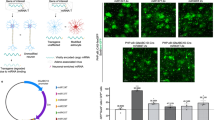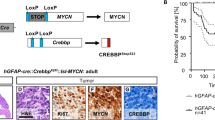Abstract
For glioma- and glioblastoma-specific gene expression, we utilized a nestin regulatory element whose activity was evaluated by the reporter gene lacZ. Nestin is a 38-kDa intermediate filament protein, and is expressed specifically in the neuroepithelial stem cells. Nestin is detected in gliomas and glioblastomas, but not in normal brain tissue. We constructed a nestin gene regulator by placing nestin's second intron before the 5′ upstream region (2iNP). To obtain enhanced expression of this tissue-specific regulator, we utilized the adenovirus double-infection method with a Cre-loxP on/off switching system. We constructed a ‘regulator’ vector, Ax2iNPNCre, which expresses Cre recombinase under the control of the nestin regulatory element, 2iNP. A ‘reporter’ vector, AxCALNLNZK, expresses lacZ under the control of a strong CAG promoter when the stuffer sequence has been removed by Cre recombinase at a pair of loxP sites. We used seven human glioma/glioblastoma cell lines: U251, KG-1C, NGM5, U87 MG, LN-Z308, NP-2 and T98G. Of these, nestin was expressed highly in U251 and KG-1C, less in NGM5, and undetectably in the other four lines. With the use of the two adenovirus vectors, we found X-gal staining and high nestin regulator-promoted β-galactosidase activities in four of the seven glioma/glioblastoma cell lines. Staining was strong in U251, KG-1C and NGM5, and less in U87 MG. LacZ expression was nearly undetectable in the non-glioma cell line, HeLa, but a little in COS-7. The adenovirus double-infection method, which uses a nestin regulator, is applicable for glioma/glioblastoma-specific expression.
This is a preview of subscription content, access via your institution
Access options
Subscribe to this journal
Receive 12 print issues and online access
$259.00 per year
only $21.58 per issue
Buy this article
- Purchase on Springer Link
- Instant access to full article PDF
Prices may be subject to local taxes which are calculated during checkout







Similar content being viewed by others
References
Mahaley MS et al. National survey of patterns of care for brain tumor patients J Neurosurg 1989 71: 826–836
Culver KW et al. In vivo gene transfer with retroviral vector-producer cells for treatment of experimental brain tumors Science 1992 256: 1550–1552
Ram Z et al. Therapy of malignant brain tumors by intratumoral implantation of retroviral vector-producing cells Nature Med 1997 3: 1354–1361
Klatzmann D et al. A Phase I/II study of herpes simplex virus type 1 thymidine kinase ‘suicide’ gene therapy for recurrent glioblastoma Hum Gene Ther 1998 9: 2595–2604
Brody SL et al. Direct in vivo gene transfer and expression in malignant cells using adenovirus vectors Hum Gene Ther 1994 5: 437–447
Wilson JM . Adenoviruses as gene-delivery vehicles New Engl J Med 1996 334: 1185–1187
Chen SH et al. Gene therapy for brain tumors: regression of experimental gliomas by adenovirus-mediated gene transfer in vivo Proc Natl Acad Sci USA 1994 91: 3054–3057
Miyao Y et al. Selective expression of foreign genes in glioma cells: use of the mouse myelin basic protein gene promoter to direct toxic gene expression J Neurosci Res 1993 36: 472–479
Chen J et al. A glial-specific, repressible, adenovirus vector for brain tumor gene therapy Cancer Res 1998 58: 3504–3507
Vandier D et al. Selective killing of glioma cell lines using an astrocyte-specific expression of the herpes simplex virus-thymidine kinase gene Cancer Res 1998 58: 4577–4580
Eng LF . Glial fibrillary acidic protein (GFAP): the major protein of glial intermediate filaments in differentiated astrocytes J Neuroimmunol 1985 8: 203–214
Besnard F et al. Multiple interacting sites regulate astrocyte-specific transcription of the human gene for glial fibrillary acidic protein J Biol Chem 1991 266: 18877–18883
Lendahl U, Zimmermann LB, McKay DG . CNS stem cells express a new class of intermediate filament protein Cell 1990 60: 585–595
Zimmerman L et al. Independent regulatory elements in the nestin gene direct transgene expression to neural stem cells or muscle precursors Neuron 1994 12: 11–24
Dahlstrand J, Collins VP, Lendahl U . Expression of the class V1 intermediate filament nestin in human central nervous system tumors Cancer Res 1992 52: 5334–5341
Lothian C, Lendahl U . An evolutionary conserved region in the second intron of the human nestin gene directs gene expression to CNS progenitor cells and to early neural crest cells Eur J Neurosci 1997 9: 452–462
Kanegae Y et al. Efficient gene activation in mammalian cells by using recombinant adenovirus expressing site-specific Cre recombinase Nucleic Acids Res 1995 23: 3816–3821
Sato Y et al. Enhanced and specific gene expression via tissue-specific production of Cre recombinase using denovirus vector Biochem Biophys Res Commun 1998 244: 455–462
Niwa H, Yamamura K-i, Miyazaki J-i . Efficient selection for high-expression transfectants with a novel eukaryotic vector Gene 1991 108: 193–200
Tanaka T et al. Adenovirus-mediated produrg gene therapy for carcinoembryonic antigen-producing human gastric carcinoma cells in vitro Cancer Res 1996 56: 1341–1345
Kanai F et al. In vivo gene therapy for α-fetoprotein-producing hepatocellular carcinoma by adenovirus-mediated transfer of cytosine deaminase gene Cancer Res 1997 57: 461–465
Pillard F et al. Suicide gene against brain tumors Hum Gene Ther 1998 9: 3–4
Miller CR et al. Differential susceptibility of primary and established human glioma cells to adenovirus infection: targeting via the epidermal growth factor receptor achieves fiber receptor-independent gene transfer Cancer Res 1998 58: 5738–5748
Yoshida Y et al. Generation of fiber-mutant recombinant adenoviruses for gene therapy of malignant glioma Hum Gene Ther 1998 9: 2503–2515
Laske DW, Youle RJ, Oldfield EH . Tumor regression with regional distribution of the targeted toxin TF-CRM107 in patients with malignant brain tumors Nature Med 1997 3: 1362–1368
Gomez-Manzano C et al. Adenovirus-mediated transfer of the p53 gene produces rapid and generalized death of human glioma cells via apoptosis Cancer Res 1996 56: 694–699
Kondo S et al. FADD gene therapy for malignant gliomas in vitro and in vivo Hum Gene Ther 1998 9: 1599–1608
Fueyo J et al. Overexpression of E2F-1 in glioma triggers apoptosis and suppresses tumor growth in vitro and in vivo Nature Med 1998 4: 685–690
Miyake M et al. Efficient generation of recombinant adenoviruses using adenovirus DNA-terminal protein complex and a cosmid bearing the full-length virus genome Proc Natl Acad Sci USA 1996 93: 1320–1324
Precious B et al. Growth, purification and titration of adenoviruses. In: Mahy BWJ (ed) Virology. A Practical Approach IRI Press: Oxford 1985 pp 193–205
Kanegae Y, Makimura M, Saito I . A simple and efficient method for purification of infectious recombinant adenovirus Jpn J Med Sci Biol 1994 47: 157–166
Hashimoto M et al. A neural cell-type-specific expression system using recombinant adenovirus vectors Hum Gene Ther 1996 7: 149–158
Acknowledgements
This work is supported by grants-in-aid from the Ministry of Education, Science, Sports and Culture. We are grateful to Dr I Saito, Laboratory of Molecular Genetics, Institute of Medical Science, University of Tokyo, for providing a cosmid vector pAxAwNCre and a lacZ expression adenovirus vector AxCALacZ.
Author information
Authors and Affiliations
Rights and permissions
About this article
Cite this article
Kurihara, H., Zama, A., Tamura, M. et al. Glioma/glioblastoma-specific adenoviral gene expression using the nestin gene regulator. Gene Ther 7, 686–693 (2000). https://doi.org/10.1038/sj.gt.3301129
Received:
Accepted:
Published:
Issue Date:
DOI: https://doi.org/10.1038/sj.gt.3301129
Keywords
This article is cited by
-
Carnosine selectively inhibits migration of IDH-wildtype glioblastoma cells in a co-culture model with fibroblasts
Cancer Cell International (2018)
-
Cell-density-dependent manifestation of partial characteristics for neuronal precursors in a newly established human gliosarcoma cell line
In Vitro Cellular & Developmental Biology - Animal (2015)
-
TRIM11 is overexpressed in high-grade gliomas and promotes proliferation, invasion, migration and glial tumor growth
Oncogene (2013)
-
Angiogenic endothelium-specific nestin expression is enhanced by the first intron of the nestin gene
Laboratory Investigation (2004)
-
Melanoma differentiation associated gene-7, mda-7/IL-24, selectively induces growth suppression, apoptosis and radiosensitization in malignant gliomas in a p53-independent manner
Oncogene (2003)



